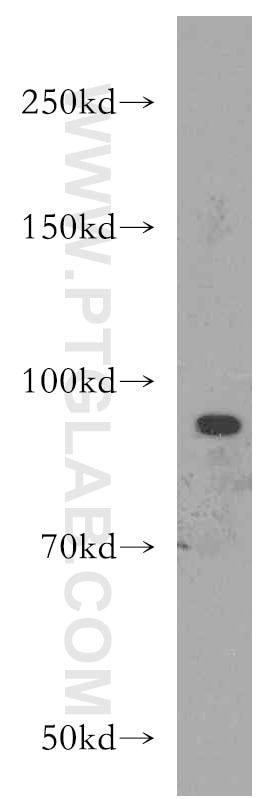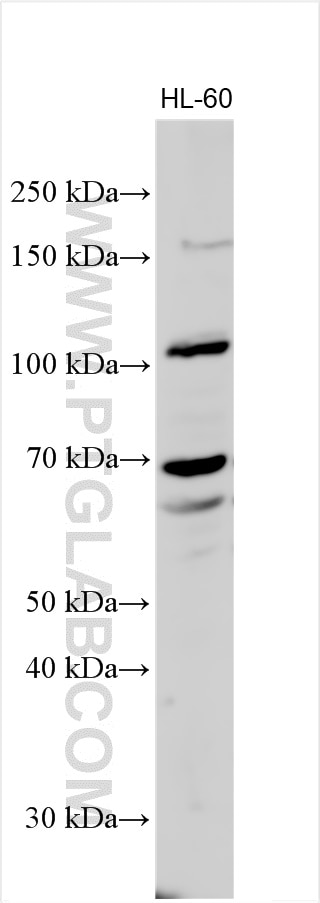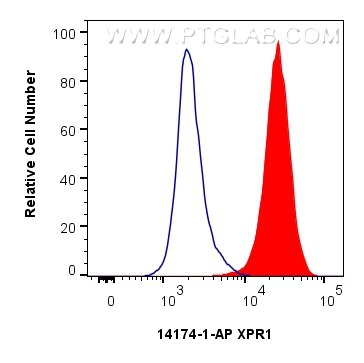- Featured Product
- KD/KO Validated
XPR1 Polyklonaler Antikörper
XPR1 Polyklonal Antikörper für WB, FC (Intra), ELISA
Wirt / Isotyp
Kaninchen / IgG
Getestete Reaktivität
human, Maus, Ratte
Anwendung
WB, IHC, IF, FC (Intra), ELISA
Konjugation
Unkonjugiert
Kat-Nr. : 14174-1-AP
Synonyme
Geprüfte Anwendungen
| Erfolgreiche Detektion in WB | Jurkat-Zellen |
| Erfolgreiche Detektion in FC (Intra) | Jurkat-Zellen |
Empfohlene Verdünnung
| Anwendung | Verdünnung |
|---|---|
| Western Blot (WB) | WB : 1:500-1:2000 |
| Durchflusszytometrie (FC) (INTRA) | FC (INTRA) : 0.25 ug per 10^6 cells in a 100 µl suspension |
| It is recommended that this reagent should be titrated in each testing system to obtain optimal results. | |
| Sample-dependent, check data in validation data gallery | |
Veröffentlichte Anwendungen
| KD/KO | See 2 publications below |
| WB | See 8 publications below |
| IHC | See 1 publications below |
| IF | See 1 publications below |
Produktinformation
14174-1-AP bindet in WB, IHC, IF, FC (Intra), ELISA XPR1 und zeigt Reaktivität mit human, Maus, Ratten
| Getestete Reaktivität | human, Maus, Ratte |
| In Publikationen genannte Reaktivität | human, Maus, Ratte |
| Wirt / Isotyp | Kaninchen / IgG |
| Klonalität | Polyklonal |
| Typ | Antikörper |
| Immunogen | XPR1 fusion protein Ag5373 |
| Vollständiger Name | xenotropic and polytropic retrovirus receptor |
| Berechnetes Molekulargewicht | 696 aa, 82 kDa |
| Beobachtetes Molekulargewicht | 82-84 kDa |
| GenBank-Zugangsnummer | BC041142 |
| Gene symbol | XPR1 |
| Gene ID (NCBI) | 9213 |
| Konjugation | Unkonjugiert |
| Form | Liquid |
| Reinigungsmethode | Antigen-Affinitätsreinigung |
| Lagerungspuffer | PBS with 0.02% sodium azide and 50% glycerol |
| Lagerungsbedingungen | Bei -20°C lagern. Nach dem Versand ein Jahr lang stabil Aliquotieren ist bei -20oC Lagerung nicht notwendig. 20ul Größen enthalten 0,1% BSA. |
Hintergrundinformationen
XPR1 is a receptor for xenotropic and polytropic murine leukemia retroviruses and a homolog of yeast Syg1 and plant Pi transporter PHO1 (PMID: 20633538). XPR1 has been identified as an atypical G-protein-coupled receptor. Xenotropic or polytropic retrovirus binding to XPR1 can disrupt the cAMP-mediated signaling function of Xpr1, leading to the apoptosis of infected cells (PMID: 22090134). A band of about 82-100 kDa is probably due to abnormal migration of the protein or post-translation modifications. In addition, a band of about 55-72 kDa may be isoforms and fragments.
Protokolle
| PRODUKTSPEZIFISCHE PROTOKOLLE | |
|---|---|
| WB protocol for XPR1 antibody 14174-1-AP | Protokoll herunterladen |
| STANDARD-PROTOKOLLE | |
|---|---|
| Klicken Sie hier, um unsere Standardprotokolle anzuzeigen |
Publikationen
| Species | Application | Title |
|---|---|---|
Proc Natl Acad Sci U S A Control of XPR1-dependent cellular phosphate efflux by InsP8 is an exemplar for functionally-exclusive inositol pyrophosphate signaling.
| ||
Cancer Sci PHOSPHATE exporter XPR1/SLC53A1 is required for the tumorigenicity of epithelial ovarian cancer
| ||
Biochem Biophys Res Commun Golgi damage caused by dysfunction of PiT-2 in primary familial brain calcification | ||
J Med Invest Effects of EOS789, a novel pan-phosphate transporter inhibitor, on phosphate metabolism : Comparison with a conventional phosphate binder | ||
Cancer Cell Int CircGNB1 facilitates the malignant phenotype of GSCs by regulating miR-515-5p/miR-582-3p-XPR1 axis | ||
Cell Rep Homeostatic coordination of cellular phosphate uptake and efflux requires an organelle-based receptor for the inositol pyrophosphate IP8 |




